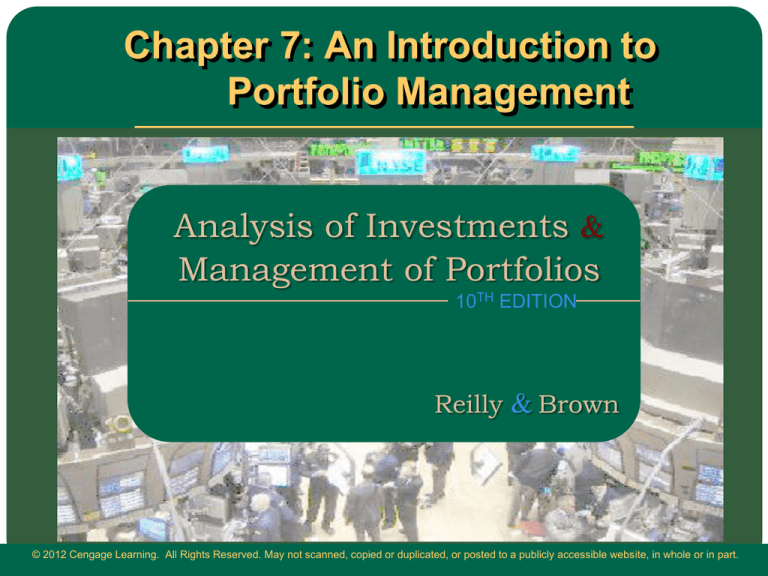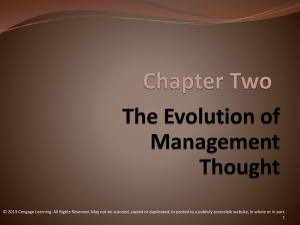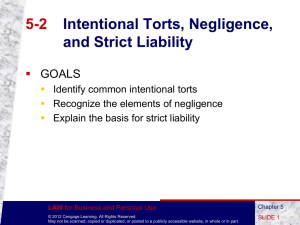
Chapter 7: An Introduction to
Portfolio Management
Analysis of Investments &
Management of Portfolios
10TH EDITION
Reilly
& Brown
© 2012 Cengage Learning. All Rights Reserved. May not scanned, copied or duplicated, or posted to a publicly accessible website, in whole or in part.
Some Background Assumptions
• Risk Aversion
– Given a choice between two assets with equal
rates of return, risk-averse investors will select the
asset with the lower level of risk
– Evidence
• Many investors purchase insurance for: Life,
Automobile, Health, and Disability Income.
• Yield on bonds increases with risk classifications
from AAA to AA to A, etc.
– Not all Investors are risk averse
• It may depends on the amount of money involved:
Risking small amounts, but insuring large losses
7-2
© 2012 Cengage Learning. All Rights Reserved. May not scanned, copied or duplicated, or posted to a publicly accessible website, in whole or in part.
Some Background Assumptions
• Definition of Risk
– Uncertainty: Risk means the uncertainty of future
outcomes. For instance, the future value of an
investment in Google’s stock is uncertain; so the
investment is risky. On the other hand, the
purchase of a six-month CD has a certain future
value; the investment is not risky.
– Probability: Risk is measured by the probability of
an adverse outcome. For instance, there is 40%
chance you will receive a return less than 8%.
7-3
© 2012 Cengage Learning. All Rights Reserved. May not scanned, copied or duplicated, or posted to a publicly accessible website, in whole or in part.
Markowitz Portfolio Theory
• Main Results
– Quantifies risk
– Derives the expected rate of return for a portfolio
of assets and an expected risk measure
– Shows that the variance of the rate of return is a
meaningful measure of portfolio risk
– Derives the formula for computing the variance of
a portfolio, showing how to effectively diversify a
portfolio
7-4
© 2012 Cengage Learning. All Rights Reserved. May not scanned, copied or duplicated, or posted to a publicly accessible website, in whole or in part.
Alternative Measures of Risk
• Variance or standard deviation of expected
return
• Range of returns
• Returns below expectations
– Semivariance – a measure that only considers
deviations below the mean
– These measures of risk implicitly assume that
investors want to minimize the damage from returns
less than some target rate
7-5
© 2012 Cengage Learning. All Rights Reserved. May not scanned, copied or duplicated, or posted to a publicly accessible website, in whole or in part.
Alternative Measures of Risk
• The Advantages of Using Standard Deviation of
Returns
– This measure is somewhat intuitive
– It is a correct and widely recognized risk measure
– It has been used in most of the theoretical asset
pricing models
7-6
© 2012 Cengage Learning. All Rights Reserved. May not scanned, copied or duplicated, or posted to a publicly accessible website, in whole or in part.
Expected Rates of Return
• For An Individual Asset
– It is equal to the sum of the potential returns
multiplied with the corresponding probability of the
returns
– See Exhibit 7.1
• For A Portfolio of Investments
– It is equal to the weighted average of the expected
rates of return for the individual investments in the
portfolio
7-7
© 2012 Cengage Learning. All Rights Reserved. May not scanned, copied or duplicated, or posted to a publicly accessible website, in whole or in part.
Exhibit 7.1
7-8
© 2012 Cengage Learning. All Rights Reserved. May not scanned, copied or duplicated, or posted to a publicly accessible website, in whole or in part.
Expected Rates of Return
If you want to construct a portfolio of n risky assets,
what will be the expected rate of return on the
portfolio is you know the expected rates of return on
each individual assets?
– The formula
n
E(Rport) WiRi
i1
where : W the percent of the portfolio in asset i
i
E(R ) the expected rate of return for asset i
i
– See Exhibit 7.2
7-9
© 2012 Cengage Learning. All Rights Reserved. May not scanned, copied or duplicated, or posted to a publicly accessible website, in whole or in part.
Exhibit 7.2
7-10
© 2012 Cengage Learning. All Rights Reserved. May not scanned, copied or duplicated, or posted to a publicly accessible website, in whole or in part.
Individual Investment Risk Measure
• Variance
– It is a measure of the variation of possible rates of
return Ri, from the expected rate of return [E(Ri)]
n
Variance ( ) [R i - E(R i )] Pi
2
2
i 1
where Pi is the probability of the possible rate
of return, Ri
• Standard Deviation (σ)
– It is simply the square root of the variance
7-11
© 2012 Cengage Learning. All Rights Reserved. May not scanned, copied or duplicated, or posted to a publicly accessible website, in whole or in part.
Individual Investment Risk Measure
Exhibit 7.3
Possible Rate
of Return (Ri)
Expected
Return E(Ri)
Ri - E(Ri)
[Ri - E(Ri)]2
0.08
0.10
0.12
0.14
0.103
0.103
0.103
0.103
-0.023
-0.003
0.017
0.037
0.0005
0.0000
0.0003
0.0014
Pi
0.35
0.30
0.20
0.15
[Ri - E(Ri)]2Pi
0.000185
0.000003
0.000058
0.000205
0.000451
2) = 0.000451
Standard Deviation ( ) = 0.021237=2.1237%
Variance (
7-12
© 2012 Cengage Learning. All Rights Reserved. May not scanned, copied or duplicated, or posted to a publicly accessible website, in whole or in part.
Covariance of Returns
• A measure of the degree to which two
variables “move together” relative to their
individual mean values over time
• For two assets, i and j, the covariance of rates
of return is defined as:
Covij = E{[Ri - E(Ri)] [Rj - E(Rj)]}
• Example
– The Wilshire 5000 Stock Index and Barclays
Capital Treasury Bond Index in 2010
– See Exhibits 7.4 and 7.7
7-13
© 2012 Cengage Learning. All Rights Reserved. May not scanned, copied or duplicated, or posted to a publicly accessible website, in whole or in part.
Exhibit 7.4
7-14
© 2012 Cengage Learning. All Rights Reserved. May not scanned, copied or duplicated, or posted to a publicly accessible website, in whole or in part.
Exhibit 7.7
7-15
© 2012 Cengage Learning. All Rights Reserved. May not scanned, copied or duplicated, or posted to a publicly accessible website, in whole or in part.
Covariance and Correlation
• The correlation coefficient is obtained by
standardizing (dividing) the covariance by the
product of the individual standard deviations
• Computing correlation from covariance
Covij
rij
i j
rij the correlatio n coefficien t of returns
i the standard deviation of R it
j the standard deviation of R jt
7-16
© 2012 Cengage Learning. All Rights Reserved. May not scanned, copied or duplicated, or posted to a publicly accessible website, in whole or in part.
Correlation Coefficient
• The coefficient can vary in the range +1 to -1.
• A value of +1 would indicate perfect positive
correlation. This means that returns for the
two assets move together in a positively and
completely linear manner.
• A value of –1 would indicate perfect negative
correlation. This means that the returns for two
assets move together in a completely linear
manner, but in opposite directions.
• See Exhibit 7.8
7-17
© 2012 Cengage Learning. All Rights Reserved. May not scanned, copied or duplicated, or posted to a publicly accessible website, in whole or in part.
Exhibit 7.8
7-18
© 2012 Cengage Learning. All Rights Reserved. May not scanned, copied or duplicated, or posted to a publicly accessible website, in whole or in part.
Standard Deviation of a Portfolio
• The Formula
n 2 2 n n
port w i i w i w jCovij
i1
i1i1
where :
port the standard deviation of the portfolio
Wi the weights of the individual assets in the portfolio, where
weights are determined by the proportion of value in the portfolio
i2 the variance of rates of return for asset i
Covij the covariance between th e rates of return for assets i and j,
where Covij rij i j
7-19
© 2012 Cengage Learning. All Rights Reserved. May not scanned, copied or duplicated, or posted to a publicly accessible website, in whole or in part.
Standard Deviation of a Portfolio
• Computations with A Two-Stock Portfolio
– Any asset of a portfolio may be described by two
characteristics:
The expected rate of return
The expected standard deviations of returns
– The correlation, measured by covariance, affects
the portfolio standard deviation
– Low correlation reduces portfolio risk while not
affecting the expected return
7-20
© 2012 Cengage Learning. All Rights Reserved. May not scanned, copied or duplicated, or posted to a publicly accessible website, in whole or in part.
Standard Deviation of a Portfolio
• Two Stocks with Different Returns and Risk
Asset
E(Ri )
Wi
σ 2i
σi
1
.10
.50
.0049
.07
2
.20
.50
.0100
.10
Case
a
b
c
d
e
Correlation Coefficient
+1.00
+0.50
0.00
-0.50
-1.00
Covariance
.0070
.0035
.0000
-.0035
-.0070
7-21
© 2012 Cengage Learning. All Rights Reserved. May not scanned, copied or duplicated, or posted to a publicly accessible website, in whole or in part.
Standard Deviation of a Portfolio
– Assets may differ in expected rates of return and
individual standard deviations
– Negative correlation reduces portfolio risk
– Combining two assets with +1.0 correlation will not
reduces the portfolio standard deviation
– Combining two assets with -1.0 correlation may
reduces the portfolio standard deviation to zero
– See Exhibits 7.10 and 7.12
7-22
© 2012 Cengage Learning. All Rights Reserved. May not scanned, copied or duplicated, or posted to a publicly accessible website, in whole or in part.
Exhibit 7.10
7-23
© 2012 Cengage Learning. All Rights Reserved. May not scanned, copied or duplicated, or posted to a publicly accessible website, in whole or in part.
Exhibit 7.12
7-24
© 2012 Cengage Learning. All Rights Reserved. May not scanned, copied or duplicated, or posted to a publicly accessible website, in whole or in part.
Standard Deviation of a Portfolio
• Constant Correlation with Changing Weights
– Assume the correlation is 0 in the earlier example
and let the weight vary as shown below.
– Portfolio return and risk are (See Exhibit 7.13):
Case
W1
W2
E(Ri)
E(σport)
f
g
h
i
j
k
l
0.00
0.20
0.40
0.50
0.60
0.80
1.00
1.00
0.80
0.60
0.50
0.40
0.20
0.00
0.20
0.18
0.16
0.15
0.14
0.12
0.10
0.1000
0.0812
0.0662
0.0610
0.0580
0.0595
0.0700
7-25
© 2012 Cengage Learning. All Rights Reserved. May not scanned, copied or duplicated, or posted to a publicly accessible website, in whole or in part.
Exhibit 7.13
7-26
© 2012 Cengage Learning. All Rights Reserved. May not scanned, copied or duplicated, or posted to a publicly accessible website, in whole or in part.
Standard Deviation of a Portfolio
• A Three-Asset Portfolio
– The results presented earlier for the two-asset
portfolio can extended to a portfolio of n assets
– As more assets are added to the portfolio, more risk
will be reduced everything else being the same
– The general computing procedure is still the same,
but the amount of computation has increase rapidly
– For the three-asset portfolio, the computation has
doubled in comparison with the two-asset portfolio
7-27
© 2012 Cengage Learning. All Rights Reserved. May not scanned, copied or duplicated, or posted to a publicly accessible website, in whole or in part.
The Efficient Frontier
• The efficient frontier represents that set of
portfolios with the maximum rate of return for
every given level of risk, or the minimum risk
for every level of return
• Efficient frontier are portfolios of investments
rather than individual securities except the
assets with the highest return and the asset
with the lowest risk
• The efficient frontier curves
– Exhibit 7.14 shows the process of deriving the
efficient frontier curve
– Exhibit 7.15 shows the final efficient frontier curve
7-28
© 2012 Cengage Learning. All Rights Reserved. May not scanned, copied or duplicated, or posted to a publicly accessible website, in whole or in part.
Exhibit 7.15
7-29
© 2012 Cengage Learning. All Rights Reserved. May not scanned, copied or duplicated, or posted to a publicly accessible website, in whole or in part.
Efficient Frontier and Investor Utility
• An individual investor’s utility curve specifies the
trade-offs he is willing to make between expected
return and risk
• The slope of the efficient frontier curve decreases
steadily as you move upward
• The interactions of these two curves will
determine the particular portfolio selected by an
individual investor
• The optimal portfolio has the highest utility for a
given investor
7-30
© 2012 Cengage Learning. All Rights Reserved. May not scanned, copied or duplicated, or posted to a publicly accessible website, in whole or in part.






